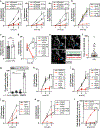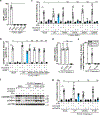Guanylate-binding proteins convert cytosolic bacteria into caspase-4 signaling platforms
- PMID: 32541830
- PMCID: PMC7381384
- DOI: 10.1038/s41590-020-0697-2
Guanylate-binding proteins convert cytosolic bacteria into caspase-4 signaling platforms
Abstract
Bacterial lipopolysaccharide triggers human caspase-4 (murine caspase-11) to cleave gasdermin-D and induce pyroptotic cell death. How lipopolysaccharide sequestered in the membranes of cytosol-invading bacteria activates caspases remains unknown. Here we show that in interferon-γ-stimulated cells guanylate-binding proteins (GBPs) assemble on the surface of Gram-negative bacteria into polyvalent signaling platforms required for activation of caspase-4. Caspase-4 activation is hierarchically controlled by GBPs; GBP1 initiates platform assembly, GBP2 and GBP4 control caspase-4 recruitment, and GBP3 governs caspase-4 activation. In response to cytosol-invading bacteria, activation of caspase-4 through the GBP platform is essential to induce gasdermin-D-dependent pyroptosis and processing of interleukin-18, thereby destroying the replicative niche for intracellular bacteria and alerting neighboring cells, respectively. Caspase-11 and GBPs epistatically protect mice against lethal bacterial challenge. Multiple antagonists of the pathway encoded by Shigella flexneri, a cytosol-adapted bacterium, provide compelling evolutionary evidence for the importance of the GBP-caspase-4 pathway in antibacterial defense.
Conflict of interest statement
Competing interests
The authors declare no competing interests
Figures


















Comment in
-
Captain GBP1: inflammasomes assemble, pyroptotic endgame.Nat Immunol. 2020 Aug;21(8):829-830. doi: 10.1038/s41590-020-0727-0. Nat Immunol. 2020. PMID: 32699406 No abstract available.
References
-
- Poltorak A. et al. Defective LPS signaling in C3H/HeJ and C57BL/10ScCr mice: mutations in Tlr4 gene. Science 282, 2085–2088 (1998). - PubMed
-
- Takeuchi O & Akira S Pattern recognition receptors and inflammation. Cell 140, 805–20 (2010). - PubMed
-
- Park BS et al. The structural basis of lipopolysaccharide recognition by the TLR4-MD-2 complex. Nature 458, 1191–5 (2009). - PubMed
-
- Shi J et al. Inflammatory caspases are innate immune receptors for intracellular LPS. Nature 514, 187–192 (2014). - PubMed
Methods-only References
-
- Randow F & Sale JE Retroviral transduction of DT40. Sub-cellular biochemistry 40, 383–386 (2006). - PubMed
Publication types
MeSH terms
Substances
Grants and funding
LinkOut - more resources
Full Text Sources
Other Literature Sources
Molecular Biology Databases
Research Materials

